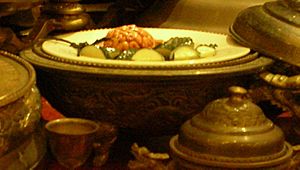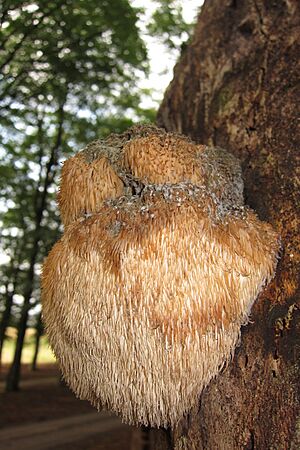Monkey brains facts for kids

Monkey brains is a dish that people believe is made from the brain of a monkey or ape. While people have eaten animal brains in many cultures (like eggs and brains or fried brain sandwiches), it's not clear if monkey brains are actually eaten. In Western movies and stories, this dish often appears when showing other cultures as strange or cruel.
Is it Really Eaten?

Some people might have confused "monkey brains" with an edible mushroom called Hericium erinaceus. In Chinese, this mushroom is called hóu tóu gū, which means "monkey head mushroom." This mushroom looks a bit like the fur of monkeys found in Asia, such as macaques. This confusion might have made people believe that monkey brains were a common dish in Asian cooking.
Historical Accounts
Some historical records suggest that real monkey brains were part of the Manchu Han Imperial banquet during the 17th century in the Qing Empire. It's said they might have been eaten directly from the skull.
A travel writer named Leila Hadley once wrote about eating monkey brains from a monkey's skull in a restaurant in Macao, near Hong Kong. However, it's not known how common this practice is today.
Modern Laws and Traditions
Today, in China, it is against the law to serve monkey brains. The government has strict rules about using certain wild animals for food. People who break these laws can face serious penalties.
In Africa, a naturalist named Angela Meder wrote about a tradition among the Anaang people in southeastern Nigeria and southwestern Cameroon. When a new tribal chief was chosen, they would eat the brain of a hunted gorilla. Another elder in the tribe would eat the heart. This practice only happened when a new chief was named, as hunting gorillas was usually forbidden. By the early 2000s, this tradition was no longer common.
See also
 In Spanish: Sesos de mono (gastronomía) para niños
In Spanish: Sesos de mono (gastronomía) para niños

